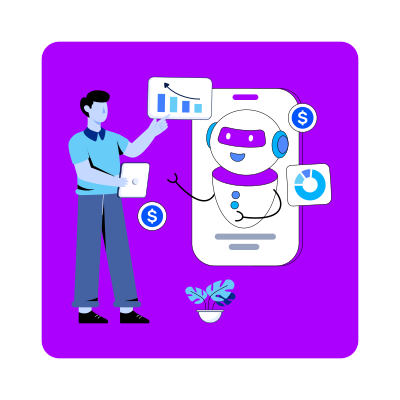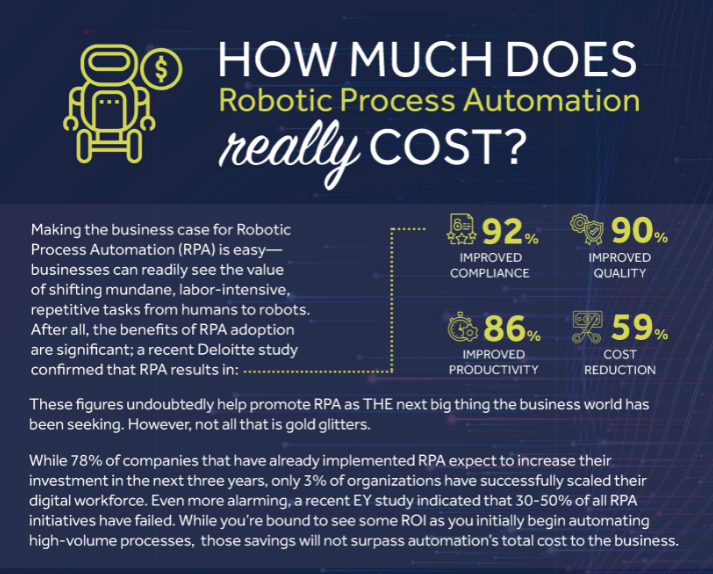6 Things to Consider When Calculating ROI for Intelligent Automation Projects
When businesses look to add a new technology solution, there are two driving factors…will this solution help me make money or will it lower existing costs?
For intelligent automation solutions such as RPA and LoCode platforms, the main goal is to lower existing costs in the form of automating manual tasks which then allow you to reallocate resources or reduce your Full-Time Employee (FTE) headcount.
On the surface, this should be simple enough to track, yet many organizations struggle to properly calculate their return on investment (ROI) for intelligent automation initiatives.
The Problem with Calculating ROI for Intelligent Automation
Many organizations calculate ROI by estimating the cost for building out a new automation, the cost to maintain that automation, and then the estimated time savings provided by automating a once manual task.
This may seem easy, yet there are several factors that can complicate this seemingly simple formula. Below are 6 things you need to consider when determining your ROI for intelligent automation projects.
#1 Redundant Automations
On average, 20%-30% of an established automation estate is redundant or wasteful. When organizations calculate the success of their automation practice, they often look at it on an individual bot level by considering how much that one bot is saving the organization, however, due to an overall lack of governance, many organizations face redundant automations, poor quality automations, and other issues that cost them money on a holistic level, which they are often not aware of.
#2 Maintenance Costs
One of the killers of a once successful automation is a high break-fix cost. This happens with complex automations that run into errors or stop working, then require a high level of skill to get them back on track. This can be hard to calculate at the beginning of a new automation project. Many organizations often underestimate maintenance costs, which can paint a very inaccurate picture of the success of your automation.
Another very expensive maintenance cost is the cost to change out an application across your entire portfolio. An example is switching from Outlook to Google Mail, which can be a very expensive project that significantly lowers the ROI of your entire automation practice.
#3 Application Licensing Costs
When we think of licensing costs for an RPA bot, we tend to think of the licensing fee for the RPA platform (think Power Automate or UiPath). However, one of the major cost drivers for an automation is the licensing cost for any software systems that the bot will need access to. Remember, an automation is essentially a digital worker, and like a physical worker, your digital worker requires access to a wide array of technology systems, such as Microsoft Outlook, your ERP system, your billing tools, and many more; all of which come with a price.
For complex automations, one bot can easily end up costing you well over $200 a month in licensing fees, which adds up to a high annual cost, which some organizations fail to account for when calculating ROI for their intelligent automation project.
#4 Inflated RPA Platforming Fees
As RPA technologies continue to evolve, their costs tend to go up as well. Many RPA platforms have acquired new technology, such as process mining tools, which eventually leads to a higher cost. Another example of rising operational expenditures is Automation Anywhere, who forced users to move to a Cloud version of their product, which came at a significant resource cost.
Due to these changes, Blueprint always recommends recalculating your Intelligent Automation ROI regularly to account for changes in your core RPA fees.
#5 Inflating RPA Resource Costs
Just like any business function, as your RPA practice continues to grow, so do your costs. As you create new automations, you may decide to hire additional, senior RPA resources, which increases the overall cost it takes to deliver and maintain an RPA bot. However, some companies fail to account for these inflating resource costs, and instead, use older estimated costs to determine ROI.
#6 RPA Design and Compliance Time
Understanding the cost it takes for a developer to build a bot can be easier to calculate, however, the cost to learn about the process, design it, understand any security risks, review it with stakeholders, and assess for compliance risks is much harder to work out.
When designing a new intelligent automation, you require many resources, including people who know and understand the process inside and out, IT personnel, and other important stakeholders across the organization. The cost for these initial meetings can add up, yet they aren’t always factored into the initial cost for creating the automation. In order to have an accurate understanding of your ROI, don’t forget to factor in all costs and time associated with creating a new RPA bot.
Conclusion
There are many other factors to consider when calculating ROI for an intelligent automation project, such as a reduction in manual errors and increases in productivity. It is important to understand these costs as accurately as possible from the beginning, as these always eventually find a way to the surface.
Share this
Recent Stories

So You’ve Been Asked to Reduce Your RPA Costs. Here Are 4 Ways to Do It

How Much Does RPA Cost? Insights From 2023

